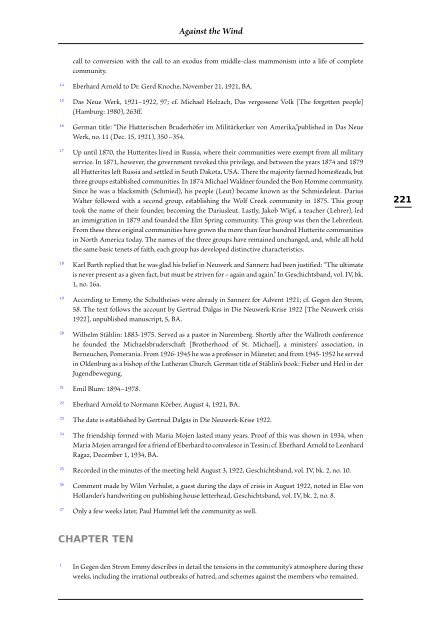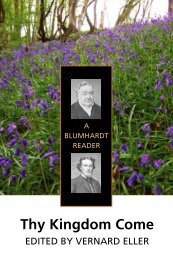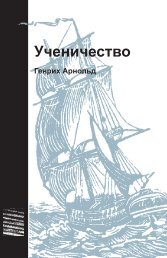<strong>Against</strong> <strong>the</strong> <strong>Wind</strong>order, peace, <strong>and</strong> safety.’” Gustav L<strong>and</strong>auer, “Zur Geschichte des Wortes Anarchie” [On <strong>the</strong> history of<strong>the</strong> word anarchy] in Der Sozialist (May 15–June 6, 1909).23<strong>Eberhard</strong> <strong>Arnold</strong> to Hans Thelemann, February 18, 1920, BA.24<strong>Eberhard</strong> <strong>Arnold</strong> to Martin Buber, May 9, 1921, BA. The project could not be carried out due to<strong>the</strong> terms of L<strong>and</strong>auer’s will <strong>and</strong> <strong>the</strong> fact that L<strong>and</strong>auer’s correspondence was widely scattered <strong>and</strong>unedited.25In 1920 Otto Herpel’s Zinzendorf: Über Glauben und Leben [Zinzendorf: on faith <strong>and</strong> life] carried anadvertisement for <strong>the</strong> “forthcoming” book Gustav L<strong>and</strong>auer in seinen Briefen [Gustav L<strong>and</strong>auer in hiscorrespondence], which was to be published by Karl Josef Friedrich.26<strong>Eberhard</strong> <strong>Arnold</strong> to Karl Josef Friedrich, November 8, 1920, BA.27A few years later Helmut von Mücke became leader of <strong>the</strong> NSDAP, <strong>the</strong> National Socialist GermanWorkers’ party, in Saxony. 22028<strong>Eberhard</strong> <strong>Arnold</strong> to Otto Herpel, April 1, 1920, BA; cf. <strong>Eberhard</strong> <strong>Arnold</strong> to Friedrich Kleemann, March17, 1920, BA.29German title: “Das Geheimnis der Urgemeinde,” printed in Das Neue Werk, no. 20–21, 160.ChaptEr ninE1<strong>Eberhard</strong> <strong>Arnold</strong> to Dr. Pfleiderer, June 13, 1920, BA.2Cf. Else von Holl<strong>and</strong>er, Sonnherz-Buch [Sunheart book], unpublished manuscript, recording <strong>the</strong>communal life in notes <strong>and</strong> sketches, from <strong>the</strong> beginnings at Sannerz until <strong>the</strong> move to <strong>the</strong> Rhön, BA.3E.g., <strong>Eberhard</strong> <strong>Arnold</strong> to Heinrich Euler, November 9, 1920, BA; <strong>Eberhard</strong> <strong>Arnold</strong> to F.W. Cordes,November 12, 1920, BA.4Friedrich Wilhelm Foerster: 1869–1966. In 1916 <strong>Eberhard</strong> obtained Foerster’s services as an author for<strong>the</strong> Furche Publishing House, but <strong>Eberhard</strong> had probably known of his writings earlier. He maintained afriendly relationship with <strong>the</strong> well-known educator for almost twenty years.5Alfred Dedo Müller to <strong>Eberhard</strong> <strong>Arnold</strong>, March 31, 1920, BA.6<strong>Eberhard</strong> <strong>Arnold</strong> to Otto Herpel, April 1, 1920, BA. In September 1921 a special issue of Das NeueWerk came out as a “Friedrich Wilhelm Foerster issue.”7German titles: Otto Herpel, Zinzendorf: Über Glauben und Leben [Zinzendorf: on faith <strong>and</strong> life];Georg Flemmig, Dorfgedanken [Village musings]; Fritz Schloss, Legenden [Legends]; <strong>Eberhard</strong> <strong>Arnold</strong><strong>and</strong> Normann Körber, Junge Saat: Lebensbuch einer Jugendbewegung [Young seed: book of a youthmovement’s life].8<strong>Eberhard</strong> <strong>Arnold</strong> to Peter Bultmann, October 5, 1920, BA.9<strong>Eberhard</strong> <strong>Arnold</strong> to Eva Oehlke, September 20, 1920, BA.10Otto Herpel to Lydia Eger, November 6, 1920, BA.11<strong>Eberhard</strong> <strong>Arnold</strong> to auditor Pucks, November 23, 1920, BA.12Friedrich Berber, Zwischen Macht und Gewissen [Between power <strong>and</strong> conscience] (Munich: 1986),31f.13Thomas von Stieglitz’s judgment (cf. Kirche als Bruderschaft, 148) is not tenable when he states thatafter <strong>the</strong> Inselsberg conference in 1919 <strong>Eberhard</strong> turned away from evangelizing <strong>and</strong> replaced <strong>the</strong>
<strong>Against</strong> <strong>the</strong> <strong>Wind</strong>call to conversion with <strong>the</strong> call to an exodus from middle-class mammonism into a life of complete community.14<strong>Eberhard</strong> <strong>Arnold</strong> to Dr. Gerd Knoche, November 21, 1921, BA.15Das Neue Werk, 1921–1922, 97; cf. Michael Holzach, Das vergessene Volk [The forgotten people](Hamburg: 1980), 263ff.16German title: “Die Hutterischen Bruderhöfer im Militärkerker von Amerika,”published in Das NeueWerk, no. 11 (Dec. 15, 1921), 350 –354.17Up until 1870, <strong>the</strong> Hutterites lived in Russia, where <strong>the</strong>ir communities were exempt from all militaryservice. In 1871, however, <strong>the</strong> government revoked this privilege, <strong>and</strong> between <strong>the</strong> years 1874 <strong>and</strong> 1879all Hutterites left Russia <strong>and</strong> settled in South Dakota, USA. There <strong>the</strong> majority farmed homeseads, butthree groups esablished communities. In 1874 Michael Waldner founded <strong>the</strong> Bon Homme community.Since he was a blacksmith (Schmied), his people (Leut) became known as <strong>the</strong> Schmiedeleut. DariusWalter followed with a second group, esablishing <strong>the</strong> Wolf Creek community in 1875. This group 221took <strong>the</strong> name of <strong>the</strong>ir founder, becoming <strong>the</strong> Dariusleut. Lastly, Jakob Wipf, a teacher (Lehrer), ledan immigration in 1879 <strong>and</strong> founded <strong>the</strong> Elm Spring community. This group was <strong>the</strong>n <strong>the</strong> Lehrerleut.From <strong>the</strong>se three original communities have grown <strong>the</strong> more than four hundred Hutterite communitiesin North America today. The names of <strong>the</strong> three groups have remained unchanged, <strong>and</strong>, while all hold<strong>the</strong> same basic tenets of faith, each group has developed distinctive characteristics.18Karl Barth replied that he was glad his belief in Neuwerk <strong>and</strong> Sannerz had been justified: “The ultimateis never present as a given fact, but must be striven for – again <strong>and</strong> again.” In Geschichtsb<strong>and</strong>, vol. IV, bk.1, no. 16a.19According to Emmy, <strong>the</strong> Schul<strong>the</strong>ises were already in Sannerz for Advent 1921; cf. Gegen den Strom,58. The text follows <strong>the</strong> account by Gertrud Dalgas in Die Neuwerk-Krise 1922 [The Neuwerk crisis 1922], unpublished manuscript, 5, BA.20Wilhelm Stählin: 1883-1975. Served as a pastor in Nuremberg. Shortly after <strong>the</strong> Wallroth conferencehe founded <strong>the</strong> Michaelsbruderschaft [Bro<strong>the</strong>rhood of St. Michael], a ministers’ association, inBerneuchen, Pomerania. From 1926-1945 he was a professor in Münster, <strong>and</strong> from 1945-1952 he servedin Oldenburg as a bishop of <strong>the</strong> Lu<strong>the</strong>ran Church. German title of Stählin’s book: Fieber und Heil in derJugendbewegung.21Emil Blum: 1894–1978.22<strong>Eberhard</strong> <strong>Arnold</strong> to Normann Körber, August 4, 1921, BA.23The date is esablished by Gertrud Dalgas in Die Neuwerk-Krise 1922.24The friendship formed with Maria Mojen lasted many years. Proof of this was shown in 1934, whenMaria Mojen arranged for a friend of <strong>Eberhard</strong> to convalesce in Tessin; cf. <strong>Eberhard</strong> <strong>Arnold</strong> to LeonhardRagaz, December 1, 1934, BA.25Recorded in <strong>the</strong> minutes of <strong>the</strong> meeting held August 3, 1922, Geschichtsb<strong>and</strong>, vol. IV, bk. 2, no. 10.26Comment made by Wilm Verhulst, a guest during <strong>the</strong> days of crisis in August 1922, noted in Else vonHoll<strong>and</strong>er’s h<strong>and</strong>writing on publishing house letterhead, Geschichtsb<strong>and</strong>, vol. IV, bk. 2, no. 8.27Only a few weeks later, Paul Hummel left <strong>the</strong> community as well.ChaptEr tEn1In Gegen den Strom Emmy describes in detail <strong>the</strong> tensions in <strong>the</strong> community’s atmosphere during <strong>the</strong>seweeks, including <strong>the</strong> irrational outbreaks of hatred, <strong>and</strong> schemes against <strong>the</strong> members who remained.
- Page 2 and 3:
Against the WindE b E r h a r d a r
- Page 4 and 5:
ContentsContents—ivForeword—ixP
- Page 6 and 7:
Against the WindMapping Out Inner L
- Page 8 and 9:
Against the WindHomecoming—164Cha
- Page 10 and 11:
Against the WindSpirit has led them
- Page 12 and 13:
Against the WindWhen were his decis
- Page 14 and 15:
Against the WindThe family tree of
- Page 16 and 17:
Against the WindIn spite of her str
- Page 18 and 19:
Against the Windhe would not recogn
- Page 20 and 21:
Against the Windlife; it was an inn
- Page 22 and 23:
Against the Winda party…go out in
- Page 24 and 25:
Against the WindintroduCtion to thE
- Page 26 and 27:
Against the WindChapter twoFor soul
- Page 28 and 29:
Against the Windthat “the presenc
- Page 30 and 31:
Against the Windwith a student name
- Page 32 and 33:
Against the Windin the SCM executiv
- Page 34 and 35:
Against the WindJena and then, foll
- Page 36 and 37:
Against the WindCourtShip and Engag
- Page 38 and 39:
Against the Windher up to date with
- Page 40 and 41:
Against the WindAugust 6: Eberhard
- Page 42 and 43:
Against the Windno other solution.
- Page 44 and 45:
Against the Windthem from entertain
- Page 46 and 47:
Against the Wind(it seems to me) th
- Page 48 and 49:
Against the Winda vocation as a fel
- Page 50 and 51:
Against the WindChapter four“The
- Page 52 and 53:
Against the WindBaptismOnce the pro
- Page 54 and 55:
Against the Windthe sermons that Sa
- Page 56 and 57:
Against the Windevening professors
- Page 58 and 59:
Against the WindThe point of Eberha
- Page 60 and 61:
Against the Windwith Emmy, who was
- Page 62 and 63:
Against the WindLeipzig-Lindenau an
- Page 64 and 65:
Against the WindDifficult matters a
- Page 66 and 67:
Against the WindEberhard still lack
- Page 68 and 69:
Against the Windsolved. Only the cr
- Page 70 and 71:
Against the Windordered by the doct
- Page 72 and 73:
Against the WindMoreover, the “im
- Page 74 and 75:
Against the Wind30, Germany on Augu
- Page 76 and 77:
Against the Windwar he had really h
- Page 78 and 79:
Against the Windcomfort that it fal
- Page 80 and 81:
Against the WindGerman in the Germa
- Page 82 and 83:
Against the WindhanS-hErmannMatters
- Page 84 and 85:
Against the Windconferences were ca
- Page 86 and 87:
Against the Windthis dreadful exper
- Page 88 and 89:
Against the WindChapter Seen“We m
- Page 90 and 91:
Against the Windparticipated in a W
- Page 92 and 93:
Against the Windlecture series, Ebe
- Page 94 and 95:
Against the Winddeclare unrelenting
- Page 96 and 97:
Against the Windfrom the compulsion
- Page 98 and 99:
Against the Windkingdom of God by c
- Page 100 and 101:
Against the Windand the old associa
- Page 102 and 103:
Against the Windcollecting subscrip
- Page 104 and 105:
Against the Windthat Emmy was on th
- Page 106 and 107:
Against the Windthe middle of Febru
- Page 108 and 109:
Against the Windand do what is good
- Page 110 and 111:
Against the Windheart in all the pr
- Page 112 and 113:
Against the WindKonrad Paul, had ma
- Page 114 and 115:
Against the WindVarious lists in Eb
- Page 116 and 117:
Against the Windmovement. Titles fo
- Page 118 and 119:
Against the Windat Sannerz celebrat
- Page 120 and 121:
Against the Windthe communal life,
- Page 122 and 123:
Against the WindAt the conference S
- Page 124 and 125:
Against the Windseemed unshaken. In
- Page 126 and 127:
Against the WindChapter tenThat pea
- Page 128 and 129:
Against the WindIn August of 1922 E
- Page 130 and 131:
Against the WindEberhard was no sup
- Page 132 and 133:
Against the WindthE fEllowShip of r
- Page 134 and 135:
Against the WindChildrEn’S Commun
- Page 136 and 137:
Against the Windformed openhearted
- Page 138 and 139:
Against the WindNordhausen and had
- Page 140 and 141:
Against the WindgEmEindEGemeinde ta
- Page 142 and 143:
Against the WindNeusonnefeld or vic
- Page 144 and 145:
Against the WindBut Eberhard did no
- Page 146 and 147:
Against the WindIt was a great help
- Page 148 and 149:
Against the Windmanifesation ofG
- Page 150 and 151:
Against the Windthe commitment made
- Page 152 and 153:
Against the Wind‘ate their bread
- Page 154 and 155:
Against the WindIf we really love c
- Page 156 and 157:
Against the Windtwo smaller childre
- Page 158 and 159:
Against the Windmeals. But Prince G
- Page 160 and 161:
Against the Windwomen who found the
- Page 162 and 163:
Against the Windon the eternal trut
- Page 164 and 165:
Against the WindChapter thirteen“
- Page 166 and 167:
Against the WindAfterwards he trave
- Page 168 and 169:
Against the WindEberhard now confro
- Page 170 and 171:
Against the Windhe went. To please
- Page 172 and 173:
Against the Windfive and a half hou
- Page 174 and 175:
Against the Windwith the Rhön Brud
- Page 176 and 177:
Against the WindhomEComingAt long l
- Page 178 and 179:
Against the WindChapter fourteen“
- Page 180 and 181:
Against the WindHutterian tradition
- Page 182 and 183: Against the Windunity and peace is
- Page 184 and 185: Against the WindThis authority and
- Page 186 and 187: Against the Windseem all the more p
- Page 188 and 189: Against the WindSannerz days, who h
- Page 190 and 191: Against the WindConfessing Synods w
- Page 192 and 193: Against the WindAfter a period of i
- Page 194 and 195: Against the WindShocked silence.Ebe
- Page 196 and 197: Against the WindFriedmann told Raga
- Page 198 and 199: Against the WindEberhard fought aga
- Page 200 and 201: Against the WindThe only other poss
- Page 202 and 203: Against the Windbrothers and a few
- Page 204 and 205: Against the WindChapter Siteen“Wh
- Page 206 and 207: Against the WindStrugglE for unityT
- Page 208 and 209: Against the Windhome for the commun
- Page 210 and 211: Against the Windjourney also bore f
- Page 212 and 213: Against the WindParadoxically, in t
- Page 214 and 215: Against the WindThree days later, o
- Page 216 and 217: Against the Windtoo Early a dEath?E
- Page 218 and 219: Against the Windfinal quEStionSWhat
- Page 220 and 221: Against the Wind7The Moravian Breth
- Page 222 and 223: Against the Wind5From Eberhard’s
- Page 224 and 225: Against the Windgelist Heinrich Dal
- Page 226 and 227: Against the Wind11Balthasar Hubmaie
- Page 228 and 229: Against the Wind29“Repentance Day
- Page 230 and 231: Against the Wind26The periodical He
- Page 234 and 235: Against the Wind2German name: Gemei
- Page 236 and 237: Against the WindChaptEr ElEvEn1Wegw
- Page 238 and 239: Against the Wind9Among these reform
- Page 240 and 241: Against the Wind22Diary entry for O
- Page 242 and 243: Against the Windwith great accuracy
- Page 244 and 245: Against the Wind1In 1933 about twen
- Page 246 and 247: Time LinemaJor EvEntS in thE lifE o
- Page 248 and 249: Against the Wind1927 May Arnolds an
- Page 250 and 251: Select BibliographyArnold, Christop
- Page 252 and 253: Against the WindGiese, Ernst. Und f
- Page 254 and 255: IndexAAlm Bruderhof 189-190, 194-19
- Page 256: Against the WindNeuwerk 89-90, 92-9

















